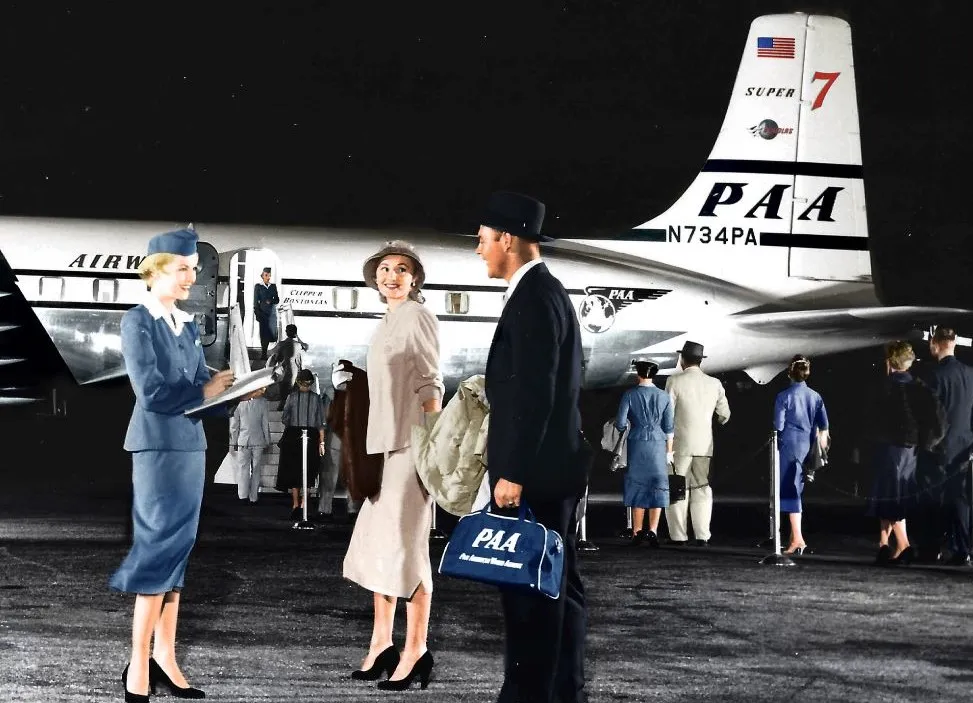
Pan American 's Classic Propliners In Colour
Apr 25, 2023

Pan American's Classic Propliners In Colour showcases the iconic era of propeller-driven aircraft that defined mid-20th century aviation. This visually stunning collection captures the elegance and engineering of planes like the Douglas DC-3 and Lockheed Constellation, celebrated for their innovative designs and significant roles in commercial air travel. The vivid imagery highlights the vibrant liveries and unique features of these classic aircraft, reflecting a time when air travel was a glamorous experience. Through detailed photography and historical context, the book pays tribute to the pioneering spirit of Pan American Airways and its contributions to the aviation industry.
When it comes to vintage aviation, few airlines evoke as much nostalgia as Pan American World Airways, commonly known as Pan Am. Their iconic propliners, such as the Lockheed Constellation and Douglas DC-6, played a pivotal role in shaping international air travel. In this article, we will explore the colorful history of Pan Am’s classic propliners, focusing on their design, operational significance, and legacy.
The Golden Age of Aviation
The period between the late 1930s and the early 1960s is often referred to as the Golden Age of Aviation. During this time, airlines like Pan Am revolutionized air travel. The company was a pioneer in transcontinental and transoceanic flights, introducing luxury and innovation into the skies. The classic propliners became symbols of this era, offering passengers an unparalleled travel experience.
Iconic Propliners of Pan Am
Pan Am operated a fleet of classic propliners that became synonymous with the airline’s brand. Here are some of the most notable models:
| Aircraft Model | Introduction Year | Seating Capacity | Notable Features |
|---|---|---|---|
| Lockheed L-049 Constellation | 1946 | 69-95 | Streamlined design, pressurized cabin |
| Douglas DC-6 | 1947 | 50-100 | Long range, four-engine configuration |
| Boeing 377 Stratocruiser | 1947 | 100 | Upper deck lounge, luxurious interiors |
| Lockheed L-188 Electra | 1959 | 66-100 | Turbo-prop engines, modern design |
Each of these aircraft contributed to Pan Am's reputation for quality and reliability in air travel. Their unique characteristics not only met the demands of the time but also set new standards for passenger comfort and safety.
Design and Color Schemes
One of the most striking features of Pan Am's classic propliners was their vibrant color schemes. The use of blue and white, along with the globe logo, became iconic. The color palette was designed to reflect the airline's global reach and commitment to providing exceptional service. The livery of these aircraft was instantly recognizable, and it played a significant role in branding.
Here is a brief overview of the livery styles that Pan Am employed:
| Era | Description |
|---|---|
| 1940s | Classic blue and white with a globe logo |
| 1950s | Striking blue and silver with larger globe logo |
| 1960s | Modernized design with a more minimalist approach |
The evolution of Pan Am's livery reflected changes in design trends and the airline's aspirations. Each iteration aimed to enhance the passenger experience while maintaining the airline's commitment to excellence.
Operational Significance
Pan Am's classic propliners were not just beautiful; they were also highly functional. The Lockheed Constellation, for example, was known for its long-range capabilities, allowing Pan Am to connect distant destinations. Similarly, the Douglas DC-6 was instrumental in expanding international routes. These aircraft not only provided reliable service but also helped establish air travel as a viable alternative to sea travel.
The operational success of Pan Am's propliners can be attributed to several factors:
- Innovative Technology: The introduction of pressurization and advanced navigation systems improved safety and comfort.
- Luxury Amenities: Features such as cocktail lounges and spacious seating areas made flying a desirable experience.
- Global Reach: The ability to fly long distances opened new markets and connected cultures worldwide.
Legacy and Influence
The legacy of Pan Am's classic propliners extends far beyond their operational years. They set the stage for modern aviation, influencing airline design and passenger expectations. Today, many aviation enthusiasts and historians celebrate these aircraft for their historical significance and aesthetic appeal.
Moreover, the fascination with Pan Am's propliners has led to numerous documentaries, books, and even merchandise, keeping the spirit of this iconic airline alive. The color schemes and designs continue to inspire contemporary airlines and enthusiasts alike.
Conclusion
In summary, Pan American World Airways' classic propliners were more than just aircraft; they were symbols of a golden era in aviation. Their innovative designs, operational significance, and vibrant color schemes left an indelible mark on the airline industry. As we reflect on the legacy of these iconic planes, it is clear that they will always hold a special place in the hearts of aviation enthusiasts around the world.
Related Articles

Explore Thailand: The Best Islands to Visit for Paradise, Adventure, and Relaxation

The Ultimate Guide to the Best Islands in Thailand for Your Next Getaway

Do babies need passports? How to get a passport for a newborn

How to get a U.S. passport fast: here’s how to expedite the process

What is Mobile Passport Control: 5 reasons why you should use it

SENTRI vs. Global Entry: A detailed guide

Do you need a passport to go to the Bahamas? Let’s find out

Do you need a passport to go to Mexico? A detailed guide

Do you need a passport to go to Canada? We got the answer

Do You Need a Passport for a Cruise: An Essential Travel Guide

Booster Seat Requirements: All the Rules to Follow in Your Rental Car

What Are the World’s Most Powerful Passports, and How Does Yours Rank?

How to Take a Passport Photo at Home: A Helpful Guide

You've got to have heart! Southwest's new livery

Your opinion: Should water be free on low cost carriers?

Young women bolder than guys as solo travellers
